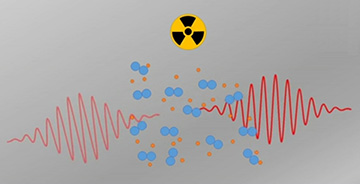![]()
A technique demonstrated by University of Maryland Scientists that uses mid-IR lasers to detect radioactive materials could, with engineering improvements, be used to scan shipping containers at busy ports of entry, at standoff distances as great as 100 meters. [Image: USDA/APHIS]
In a global economy dominated by mass flows of containerized shipping and cross-border transport of trucked goods, detecting hazardous or illegal materials constitutes an increasingly important and tough challenge. For radioactive material in particular, the conventional methods of detection—inspection using a Geiger counter or other handheld device, which requires close-in access to the suspect sample—do not scale well for use at busy ports of entry for shipping.
Now, a research team at the University of Maryland, USA, led by OSA Fellow Howard Milchberg, has demonstrated a proof-of-concept system that uses mid-infrared lasers to detect radioactive material (Sci. Adv., doi: 10.1126/sciadv.aav6804). The researchers believe that, with an additional engineering effort, the approach could ultimately find use at points of entry for detecting radiation in shielded containers, at standoff distances as great as 100 meters.
Electron avalanche breakdown
The Maryland team’s method works through detection of a phenomenon called laser-induced electron avalanche breakdown.
Near a radioactive source, alpha, beta and gamma radiation from the source ionizes the atmospheric gases in the immediate vicinity, creating a soup of positively charged ions and electrons. Sending a high-intensity electromagnetic field, such as a laser pulse, through that patch of ionized air accelerates those free electrons. That, in turn, pushes the free electrons into other gas molecules, triggering further ionization, in a sort of chain reaction that gives rise to an electrically conductive plasma—until a plateau is reached and growth of free electrons slows.
Milchberg, along with the new study’s lead author, grad student Robert Schwartz, and colleagues, noted that the oscillations and ionization driven by the laser would result in a time shift in the backscattered radiation from the pulse. What’s more, the “breakdown time”—the time it takes for the laser-driven electron breakdown to become measurable—depends on the density of free electrons initially present in the laser focal volume, and thus to the amount of radioactive material in the area. Together, these considerations suggested the possibility of a system that could use laser-induced electron avalanche breakdown to detect radioactive material at a distance.
Proof of concept

The technique uses a mid-IR laser source to trigger an electron avalanche in air ionized by nearby radioactive material, which results in a backscattering of part of the pulse energy. The characteristics of that backscattered energy can be mapped to the amount of radioactive material. [Image: R. Schwartz/H. Milchberg/U. of Maryland]
To test the concept, the team set up a benchtop hybrid optical parametric amplifier (OPA)/optical parametric chirped-pulse amplification (OPCPA) system that produced two pulses: A weak, 70-ps probe pulse at a near-IR wavelength of 1.4–1.5 μm, and a higher-energy, 50-ps pump pulse at a mid-IR wavelength of 3.9 μm. The pump pulse was used both to drive electron avalanche breakdown and to provide a backscattered signal from the breakdown area that could be used to measure the breakdown time. The probe pulse, which passed through the breakdown area and was captured in a photodetector for spectroscopic analysis, provided a reference signal for the breakdown process that could be compared with the backscattered signal.
The researchers aimed these pulses at an air patch near a sample of radioactive polonium-210 foil, a potent source of ionizing alpha particles. They were able to use spectroscopic analysis of the chirped near-IR probe pulses to carefully track the time evolution of the electron avalanche breakdown for different values of pump laser intensity, distance and initial ionization. And they found they could map the evolution recorded in the probe pulse to changes in the backscattered signal of the longer-wavelength pump pulse.
Toward a scaled-up system
The researchers acknowledge that a lot of work remains to scale their benchtop system up to a field-ready setup suitable for busy ports of entry. One challenge will be tweaking the intensity, wavelength and spot sizes of the laser to kick off electron avalanche breakdown near radioactive materials 100 meters away—while still keeping the intensity low enough to avoid triggering breakdowns due to the thin, natural background of ionized oxygen in the atmosphere that’s tied to cosmic rays. The team is working on these and other engineering improvements toward taking the system from proof-of-concept to field prototype.
Lead author Schwartz is optimistic, however, that the system could ultimately provide an additional aid for addressing a tough problem at ports of entry. “Right now we’re working with a lab-sized laser,” he noted in a press release accompanying the research. “But in 10 years or so, engineers may be able to fit a system like this inside a van. Anywhere you can park a truck, you can deploy such a system. This would provide a very powerful tool to monitor activity at ports.”
